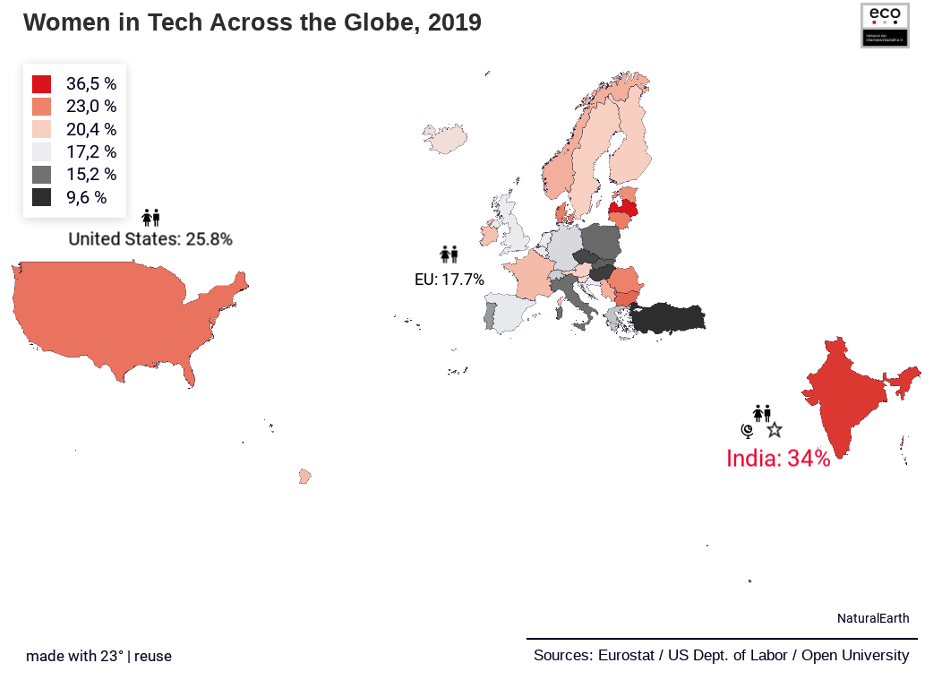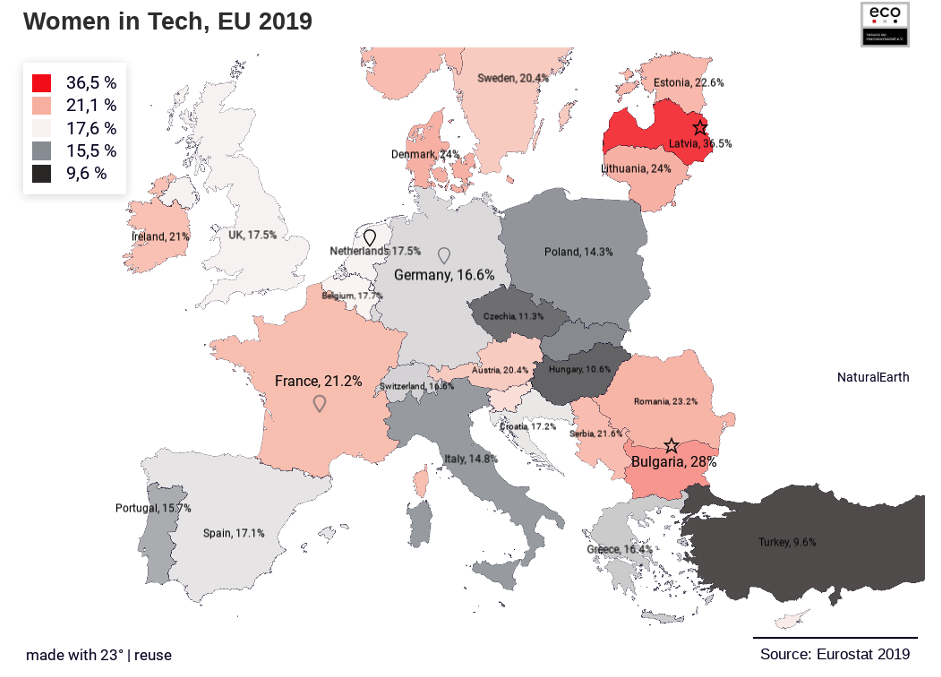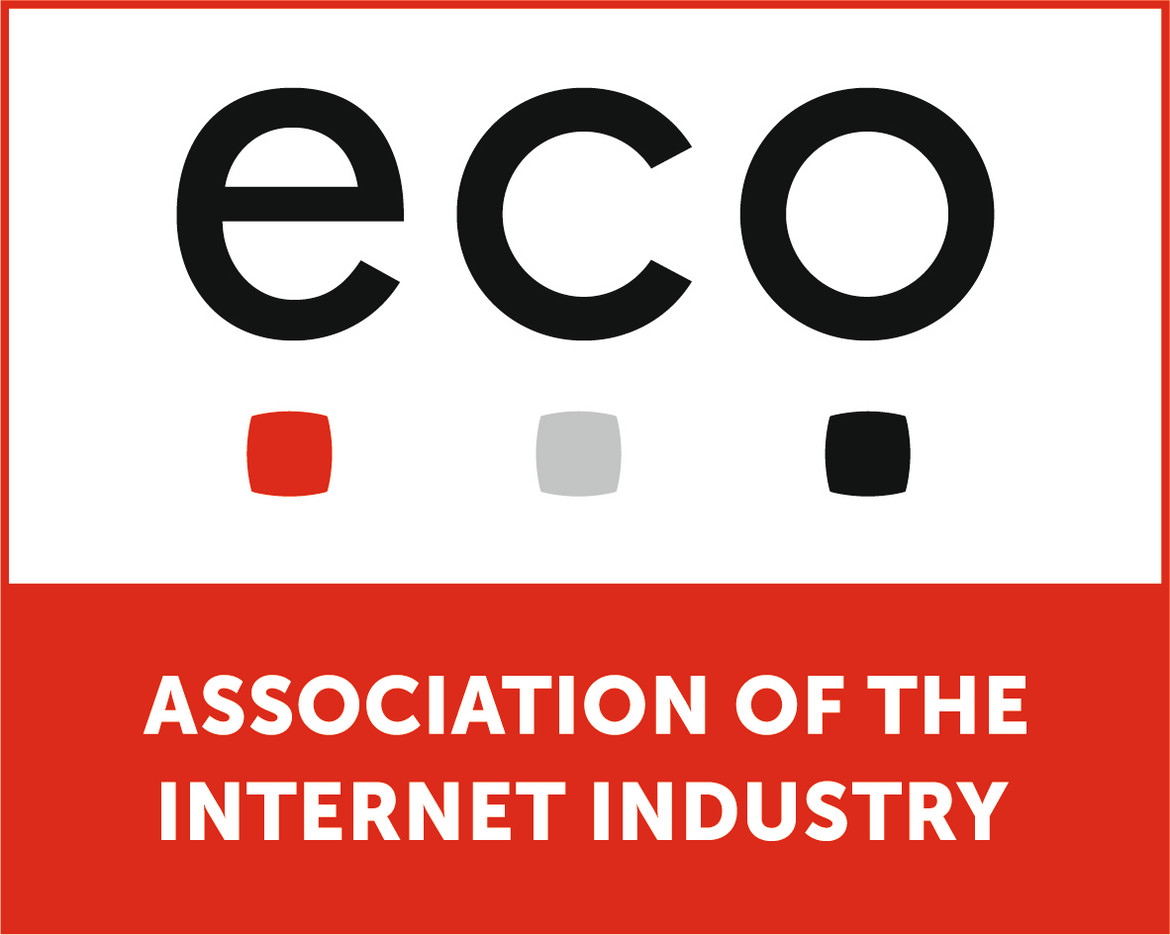Women in Tech – How to Get Started
Why you should be promoting gender diversity in your company, and how to take the first steps, explain Eilín Geraghty & Lars Steffen from the eco Association.

© SIphotography | istockphoto.com
When it comes to economic indicators, companies who promote diversity within their ranks and support women in tech display a distinct advantage. The impacts of diversity on revenues are manifold and positive. For example, highly inclusive organizations are 1.7 times more likely to be innovation leaders in their respective market. [1] Companies with above-average diversity generate both 19 percent higher innovation revenues and nine percent higher EBIT margins.[2] And companies with high levels of gender diversity, in particular, are 15 percent more likely to have financial returns above the national industry medians.[3]
But it’s not only about economics, it’s also about filling skills gaps. In 2018, for example, ICT staff ranked third in Germany and sixth across the globe among the top 10 jobs employers were having difficulty filling.[4] Also in 2018, 43.6 percent of European manufacturers and more than 28 percent of service firms already said they expected labor shortages to limit their production.[5] In the next 15 years, the demand for advanced IT and programing skills is expected to jump by 90 percent.[6] And by 2025, the labor shortage of ICT workers is forecast to be 625,000 in Germany and 520,000 in France.[7] These are just a few of the figures. But it’s about more than just numbers. It’s about accessing the world’s greatest untapped talent pool – helping women find their feet in the technical world, and in so doing preparing ourselves as a whole more effectively for the future.
As Agustina Callegari, Senior Manager Community Engagement at the Internet Society, puts it: “In the tech ecosystem, while there are many billions of women using the Internet for improving people’s lives, women are still underrepresented in the workforce and also in leadership positions. That means that the Internet needs more women. We need women to have a voice in the evolution of the Internet, to connect, to create, to innovate and to seize the opportunity that the Internet offers. And also to inspire others.”
Moving towards gender parity?
For many reasons then, it is absolutely imperative that we have more women in tech. And for those companies that are striving towards this goal, we think it’s very useful to be able to ground the conversation by getting a handle on and referring to data from around the globe. So the UN, for example, have set the target that by the year 2030, there would be 50-50 gender parity across all industries across the globe.
We in the tech industry would like to think that, in our industry, because we are so future-oriented, we will perhaps be a step ahead when it comes to gaining ground in gender parity. To see whether this is in fact the case, let’s take a look at figures from around the world. First, looking at the star performer around the world, India: In this massive country, one out of every three tech professionals is a woman. In the United States, it’s one out of every four, but in the EU, unfortunately, the number of women employed drops to around one out of every six tech professionals.

Looking at the EU in greater detail, we see that the star performers in the EU are countries such as Bulgaria and Latvia. Latvia, for example, has twice as high a proportion of women in tech as countries such as Germany, and four times as high a level as the numbers in Turkey. When also considering countries such India, we can see that there is a trend among a number of middle-income countries around the world to have a greater embracing of digitalization and also an appreciation that women very much need to be part of that in order to make progress. In such countries, women themselves demonstrate less skepticism about choosing a career in the technical world.

Turning around the downward trend
But so far, we have been focused on a moment’s snapshot of the world’s women in tech. It is also important to see whether there has been change over time. Unfortunately, looking at the EU, the average rate of female representation in the tech industry has been declining for years.
Comparing the EU figures for 2008 and 2018, we learn that in 2018 there was a six percent lower proportion of women in tech than a decade previously. Although there is no equivalent comparison that we can make for the US, it is possible to make the comparison across two decades. Here, we see that more than one out of every three tech professionals in 1991 was a woman, whereas this has fallen to just over one in four today.
So, how can we turn this downward trend around?
Joyce Dogniez, Vice President Community Engagement at the Internet Society, recently explained that one of the most important steps is understanding the needs of women in a currently male-dominated industry, and highlighting strong female role models – to give women in the tech industry the feeling that firstly, they are not alone, and secondly, that there is the potential for them to move up the career ladder.
“I had the honor recently of being invited to participate in a webinar by our Berlin chapter, where we discussed the challenge of female inclusion in leadership positions, both in volunteer environments as well as in the workspace.
During the discussion, we heard that young women and girls drop off at an early age from the more technical careers. We heard that women need to work twice as hard as men, or even more in some cases, to achieve the same things. We also heard that women are still paid less. We heard that women need to be asked and encouraged. It was generally felt that it was really critical to have role models in our space and that it’s also everybody’s responsibility – both men and women – to really promote and advance equality in the Internet ecosystem, and therefore also in the work space.”
But with so few women represented in the industry, it may seem like an uphill battle to find such role models. However, this is not necessarily the case, as Agustina Callegari from the Internet Society contends:
“The lack of roles models is not because there are no women in tech. There are many that have achieved great feats. While it is true that we can find amazing women in history, it is important to highlight that we don’t have to go far to find great women in the industry. You can just look around you, at your workplace, in your community, because there are many.”
How to kick start a diversity program in your company
So for those of us – companies, organizations, associations – that are striving for greater gender parity, what is perhaps the first action that can work? Erica Varlese from Automattic, quoted in the eco Association study “Women in Tech Across the Globe: A Good Practice Guide for Companies”, says that “It wasn’t until we started setting actual goals that we really began to make solid progress. Setting goals allows you to break down these larger ideals into smaller, achievable victories.”
And in the eco Association we see this as being the need to start with a plan, which you could call perhaps a Gender Equality Strategy.
1. The first step is to assign a senior executive sponsor to oversee the plan. Perhaps that sponsor would consider introducing unconscious bias training across teams, or in larger companies set up a diversity board.
2. A second step would be to convey a core message from the strategy, for example, “As a tech company, we not only benefit from strengthening pathways for women into tech, but we are also uniquely situated to do so.”
3. And a third step would be to identify priority policies such as recruitment, new work culture, leadership, and building the pipeline of female talent. The eco Association has recently published a set of guidelines which provides a multitude of tips for actions for each of these policies. The study, “Women in Tech Across the Globe: A Good Practice Guide for Companies”, is available as a download for anybody who would like to look into that in more detail.
But if you want a simple starter to get the ball rolling on increasing the visibility of the women you already have in your company, find a way to highlight their work and put them more into the spotlight. Reg Levy, Head of Compliancy at Tucows and Co-Chair of the Diversity and Inclusion Initiative at the i2Coalition, sees diversifying monochromatic panels as an easy-to-implement first step on the road to gender parity:
“One of the most important resources that the i2Coalition’s Diversity and Inclusion Initiative provides is panel recommendations. If you are in charge of putting together a panel of experts and simply don’t know any women, any people of color, or any people from other diverse backgrounds to help you populate it, you can reach out to your network and ask specifically. You can reach out to eco. You can reach out to ISOC, i2C, or anybody else that you know, to ask for exactly what you’re looking for.
“The more that everybody sees diversity on panels, the more natural it will become. If you can see it, you can be it. Putting women, people of color and people from other diverse backgrounds on technical and subject matter expert panels is a choice that you can make. We’re out there. Just ask around. This isn’t just for public panels, but also within your own company. Does someone need to give a presentation for your team? Is there an opportunity to make a presentation to management? Be a sponsor for your team members, and put forward diverse names.”
So the message is simple – it doesn’t need to be difficult, and you just need to start.
Darcy Southwell, Compliance Officer for Endurance International Group and Co-Chair of the i2Coalition Diversity & Inclusion Initiative, counsels: “You do not need to be a high-level vice president to change the culture. Every one of us, no matter what position you’re in within a company, can do tangible things every day to help support diversity and inclusion within the workplace and help support and advocate for the growth of women in tech.”
Eilin Geraghty is Project Manager in the eco International team at eco - Association of the Internet Industry, and author of the eco Association study “Women in Tech Across the Globe: A Good Practice Guide for Companies”.
Lars Steffen is Director International at eco – Association of the Internet Industry (international.eco.de), the largest Internet industry association in Europe. At eco, he coordinates all international activities of the association and takes care of the members from the domain name industry and the blockchain community. He further represents the industry as Community Outreach Co-Coordinator of the Universal Acceptance Steering Group at the Internet Corporation for Assigned Names and Numbers (icann.org), to facilitate the support of internationalized domain names and email address internationalization.






